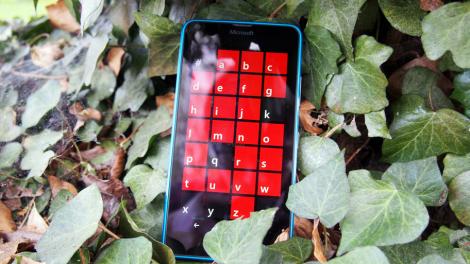
Introduction and design
The Microsoft Lumia 640 is among the first in a new breed of Windows Phones. With a larger screen, more RAM and a different design language from its predecessor, this is Microsoft stamping its logo (literally) on the Lumia range. And what a change this proves to be.
The old Nokia did things a little differently. Budget devices made by the Finnish firm were notoriously bare-bones; this could be seen in the decision to omit Gorilla Glass and limit RAM in models such as the Lumia 520 and 630, among others.
Value was added for the consumer through access to services such as MixRadio and HERE Maps. Microsoft takes something of a different tack.
Those who purchase a Microsoft Lumia 640 will receive several sweeteners, such as 30GB of free OneDrive storage and a one-year subscription to Office 365. These in themselves are nice, especially for the price. However, when paired with a phone that rivals (and exceeds) the ever-popular Moto G in many areas, even in its newer incarnation, heads will start to turn.
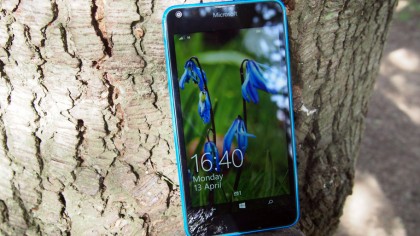
When it comes to specs, the Microsoft Lumia 640 does not disappoint. The device has a 5-inch, 720p screen with 294 PPI, a quad-core Snapdragon 400 processor clocked at 1.2 GHz, 1GB of RAM and 8GB of internal storage. These are exceptionally healthy specifications for the £130, $250 (around AU$320) SIM-free price point.
Though these specifications might appear exceptional, the competition is quite fierce. Devices such as the Honor Holly, Moto G (2014) and EE Kestrel all offer unique advantages at the same price point, while also being able to access the more than one million apps available on the Google Play Store.
As such, the question is, can an Office and OneDrive subscription sell the Microsoft Lumia 640? Will this be the budget hero device that Windows Phone needs?
Design
When I received the Microsoft Lumia 640, I was not especially impressed. My review device was constructed of a glossy cyan plastic, which was unpleasantly reminiscent of older Samsung devices.
I don’t have the greasiest fingers in the world, however after five minutes of using the Lumia 640, it looked as if I had wiped it with a pepperoni pizza.
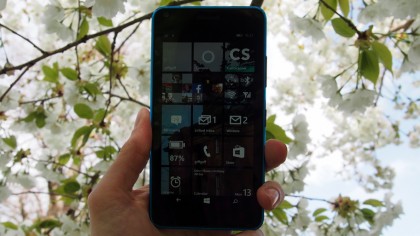
Luckily, the back cover of the device is removable, allowing you to switch in a number of different options, meaning (mercifully) that matte covers are available for those who might want them, along with other suitably ‘Lumia’ options, including black and orange.
Coming from a smaller device, as I had, it took a little while before I was confident enough to use the phone one-handed. The glossy plastic back meant the phone had a tendency to skate across tables with reckless abandon, so a case might be a wise investment for some.
Though well-balanced in the hand, the shell itself does not feel especially sturdy. Coming from a device such as the Lumia 435, which could sink a ship, the Lumia 640 LTE does not impress overly.
Looking at the side of the device, the black of the inner portion was clearly visible through the plastic, looking as though it might crack easily were it to fall.
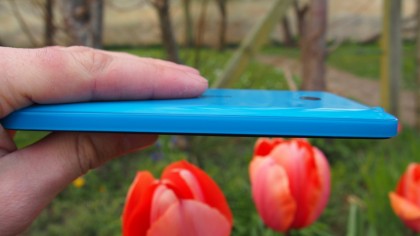
Once the back has been removed, access is given to the Micro-SIM slot, the removable 2500mAh battery and the MicroSD slot, which takes cards up to 128GB in size.
The sides of the Lumia 640 LTE are clean and uncluttered, and in the traditional Lumia fashion everything of note is thrown to the right of the phone. No sharp edges are to be found, and using this phone either one- or two-handed is a pleasant and comfortable experience.
The power button and the volume rocker have a decent travel and a nice click to them, meaning everything is easy to find.
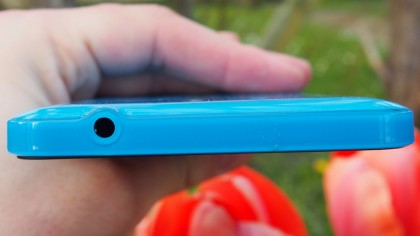
A single Micro-USB slot is tidied away on the bottom of the device, while the ever so slightly roughly hewn 3.5mm headphone jack is on the top, as might be expected.
On the back of the Lumia 640, there is a single rear-firing speaker, a neatly displayed Microsoft logo, a single LED flash and the 8MP rear-facing camera.
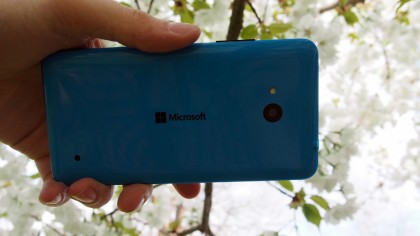
The front of the device contains the 5-inch screen, a 0.9MP selfie camera and the usual additions of a call-speaker and microphone. With Gorilla Glass covering the front panel, the oleophobic coating immediately makes itself known, feeling very pleasant to the touch.
Overall, this is a utilitarian but nice device for the price. Though Microsoft doesn’t take any great gambits with the design, the phone is light, well balanced and pleasant to use both one- and two-handed.
Key features
Screen
It is interesting to see how far phone screens have progressed in the budget range. Whereas a few years ago, spending less than £200, $300 on a smartphone doomed you to excessive pixelation, now things are very different.
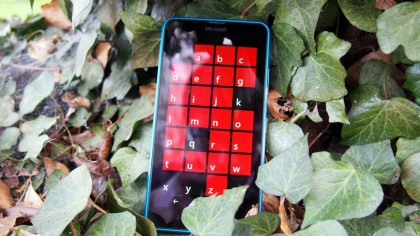
The Moto G (2013) wowed the world with a 720p screen at a less than flagship price several years ago, and now the Lumia 640 joins the club.
With a 5-inch panel, the Lumia 640 certainly sports a comfortable amount of real-estate on which to consume media and play games.
And at 294 PPI, though not quite ‘Retina’ in its quality, the screen should please everyone (pixel peepers aside). Web browsing was an enjoyable experience, as was viewing HD video.
In the best Lumia tradition, the abilities of the Microsoft Lumia 640’s panel do not end there. As mentioned, the Gorilla Glass protection makes using the device a very easy experience.
The nice ‘ClearBlack’ polarisation filter used previously by Nokia has been applied, meaning that the device has very nice black levels for an LED screen; this makes it easy to use outdoors.
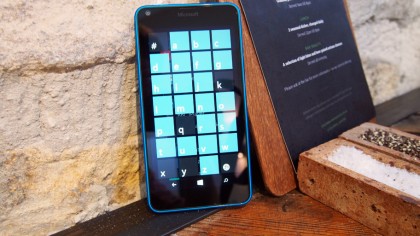
As it is an IPS panel, viewing angles are also excellent. Unusually, for a budget device, the Lumia 640 LTE sports both double-tap to wake and the ever-useful Glance mode, which is configurable to allow for a number of different notifications to appear.
Automatic brightness is also a nice addition, seeing as this was omitted on the Lumia 630; this makes daily use a little easier, while extending the battery a little.
Nokia always had a strong reputation for the quality of the panels it produced, and if this is anything to go by, Microsoft intends to continue the tradition in style. The screen on the Lumia 640 LTE is one of its main highlights, and is easily one of the best available at this price point.
Office suite
Since Satya Nadella became CEO in 2014, Microsoft has made a strong play for its cloud services. Lumia owners have long had access to Office and OneDrive; however, with the Lumia 640 Redmond has made its strongest push.
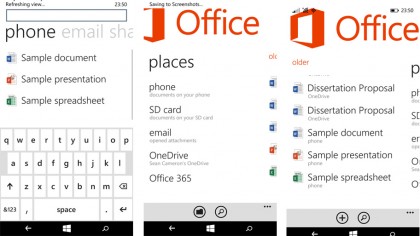
Included with the Lumia 640 LTE is a free one-year subscription to Office365 and 30GB of free OneDrive storage. On paper, this is an enormous saving, and it definitely adds value to the device.
OneDrive is certainly a pleasure to use. I found that pictures I took uploaded to the cloud with a minimum of fuss, easily beating Dropbox for speed.
The same was true when accessing files online; the service was consistent and functional, if not remarkable in any regard.
It has long been a necessity for Windows Phone owners to deal with OneDrive in one form or another if they wished to make use of cloud storage, and with 30GB free it is likely that many more will make the jump.
As for the Office 365 subscription, this is where things become a little more difficult. If you are a business owner, the ability to easily sync Word, Excel and Powerpoint files, along with editing them on the go, will no doubt be attractive.
For the average user, however, productivity is as sexy as ever, but Excel will most likely struggle to sell phones. Despite this, it is a nice addition. The Office app for Windows Phone is laid out sensibly and has a number of basic editing options, which remain a little more advanced than their Android and iOS counterparts.
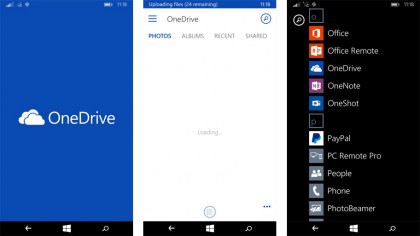
Though typing a 3,000-word essay on a 5-inch screen is as attractive a proposition as ever, for basic tasks on the go, it is more than sufficient. As Microsoft clearly wishes to demonstrate, this is a phone for business as well as pleasure. However, the divide can sometimes be a little too stark.
Windows Phone 8.1 Update 2
The Microsoft Lumia 640 and the Lumia 640 XL are the first devices to arrive toting the latest update for Windows Phone – the drably titled Windows Phone 8.1 Update 2.
Typically, when Windows Phone has been updated, exciting names have been dreamt up, and with the new software came a number of new features. Yet, with Windows 10 on its way later in the year, all focus has been diverted to the task at hand, and this latest update has suffered as a result.
Windows Phone 8.1 Update 2 brings with it a number of bug fixes and stability improvements, and one feature that has been missing from Windows Phone from the start: the ability to pin setting options to the Home screen.
In the past, users had to be content either arranging and using the notification tray or swiping through to the settings menu if they wished to access options such as Wi-Fi or mobile data. Aside from a few third-party app options that could solve the problem partially, this could mean on occasion that using Windows Phone was a pain.
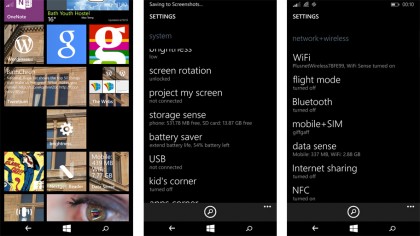
As such, I immediately pinned brightness, Wi-Fi and mobile data to the Home screen, which made general use far easier. Windows Phone 8.1 Update 2 also comes with a rearranged setting menu.
Windows Phone no longer has an endless list of random settings, and different options are grouped according to their functions.
I am something of a Windows Phone veteran, and I found these changes all much to my liking. And though newcomers to the mobile OS may find these changes to be simple common sense, they will most likely be welcome nonetheless, making this a quiet triumph.
Cortana
What is there to say about Cortana that has not already been said?
Microsoft’s virtual assistant has been available for Windows Phone owners in the UK since the rollout of the Lumia Denim update in late 2014/early 2015, and it is safe to say that she has been met with a mostly positive reception.
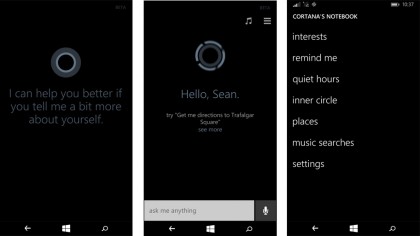
Combining some of the personality of Siri with some of the pre-cognisance of Google Now, along with a little Microsoft secret sauce, Cortana is generally a pleasure to use.
Cortana can perform web searches, compose messages, create reminders – everything that has become the bread and butter of voice assistants everywhere.
In addition to this, she can also interact with select third-party apps, although this function must be baked in by developers, and as such support is somewhat limited at present.
Everything Cortana knows about you is bundled into her ‘notebook’, which also contains a list of all of her permissions. Here, in a nice departure from the relatively opaque confines of Google Now and Siri, it is easy to control the information that Cortana can access about you.
Though it isn’t possible with the Lumia 640 LTE to turn on ‘always listening’ voice activation, as it is with the likes of the Nokia Lumia 930 and the Lumia 1520, by pinning a tile to the Home screen, I found Cortana to be useful.
Though she is limited to searching through Bing, Cortana is fast becoming the big-value add-on that Microsoft so clearly wishes the service to be.
Performance and battery life
With the Lumia 640, Microsoft has held true to one of the proudest traditions of the 600 range: a healthy processor. Purring away under the hood of the polycarbonate slab is a quad-core Qualcomm Snapdragon 400 processor, clocked at 1.2 GHz. This is the very same processor found in the Moto G (2013), and as such is a tried and true performer.
I found that swiping around the OS was a pleasant experience. The usability of Windows Phone at the lower end of the price spectrum has often been touted as excellent. Approximately 50% of this general impression is based in reality – in my experience the operating system masks app loading times with myriad animations.

As such, it is a pleasure to say that, on the Microsoft Lumia 640, I did not find this to be the case. The best test of OS responsiveness is a measure of the ‘app rehydration’, or app refresh times when multi-tasking.
When loading apps such as Spotify from sleep, there was functionally no delay, whereas on a device such as the Nokia Lumia 540, this could easily be upwards of five seconds. The Lumia 640 is a scorcher, at least when swiping around.
Happily, this general level of performance continued into gaming performance. Whatever I threw at it, the device mostly took it in its stride. Games such as Subway Surfers, Sparkle 2 and Timberman ran without a hitch.
Though Windows Phone has often lagged behind in the processor department when compared to supercharged Android phones such as the Samsung Galaxy S6 and the HTC One M9, at least in the budget range Microsoft appears keen to catch up.
Battery life
To put it simply, the battery life of the Microsoft Lumia 640 is excellent.
With a relatively low-resolution display, a power-sipping processor and the efficient Windows Phone OS, the ingredients were all there for the success of the Lumia 640.
When matched with a large 2500mAh unit, all of these factors virtually guarantee that the device will last comfortably through a long day of work and play.
Unplugging the device at around 7:30am, listening to a few hours of Spotify, catching up with a few shows on BBC iPlayer Radio, browsing the internet for around an hour on HSDPA+ and whiling away dull moments with a little gaming saw the battery drop to around 45% by 6pm.
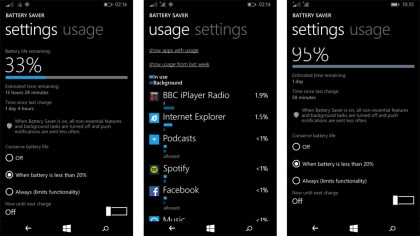
Leaving the device unplugged throughout the night, I saw a further 2% drop, leaving ample charge for the next day.
In all, regardless of your use case, this device has great battery life. And, as a bonus for those who travel frequently, and power users, it is removable, allowing for ‘hot-swapping’ a new unit in to top things up.
To help last through the day, Windows Phone comes bundled with a battery saver app, which comes with a powerful power-saving option. When activated, this allows background tasks to be shut down completely, except for whatever app is being used directly, limiting connectivity significantly, but proving useful in a pinch.
For me, activating this option dependably added around two to three hours to battery time. Typically, this gave an estimated 28 hours of power, and with power saver it increased to 31. Though it doesn’t include any fancy greyscale power-saving options, as found on the Samsung Galaxy S6, this is a dependable and practical alternative.
Overall, I was very pleased with the battery life of the Microsoft Lumia 640 LTE. I came to the device with high expectations, given its screen, processor and the size of its battery unit, and yet was pleasantly surprised.
The essentials and camera
The essentials
One thing, among many others, that Nokia phones were always known for was the (relatively) crystal clarity of voice calls its devices were capable of.
Throughout the Lumia line, this has been something of an understated, but crowning feature, and happily the Microsoft Lumia 640 continues in this tradition.
Calls made from the device were pleasantly loud and rounded, and callers remarked on the quality at the other end. Though not quite up to par with the likes of ‘HD’ voice calls offered by some network providers, the Lumia 640 is a pleasant call-making device indeed.
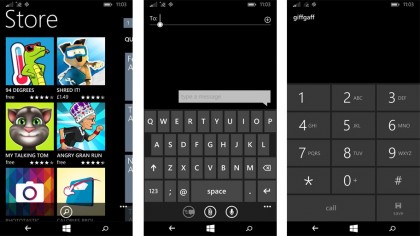
Radio performance also proved to be something of a high point, with clear HSDPA+ performance across the Bath, Bristol, Swindon and Cardiff areas. This proved to be true even in areas where I have often found it difficult to gain reception.
Pages loaded quickly on the baked-in Internet Explorer browser, though the app has some issues with ‘pop-in’. Microsoft has tinkered with the code behind this to mimic Safari, and as such performance is similar on many sites to Apple’s native browser.
With a configurable reading mode, desktop mode and many other settings, the browser is moderately customisable, which will no doubt please tinkerers. And with a bottom-mounted address bar, one-handed use is a very practical option.
Aided by the generously spaced keys of the on-screen keyboard, along with the fluid and reliable gesture mode and predictive text functions, the Windows Phone typing experience remains a joy. This remains true even in the face of increasingly serious competition in the Android space from the likes of Swiftkey and Swype.
The rear-facing speakers on the device produced a satisfying level of volume, with noticeable distortion not making itself known until the highest levels.
Finding apps on Windows Phone remains something of a problem. If they are available at all, apps are often a little more limited or buggy than their counterparts on other mobile operating systems, very rarely receiving updates.
Lastly, but not least, GPS performance on the device was acceptable. No matter where I found myself, getting a lock and navigating elsewhere was always a quick experience, with little in the way of jitters or lag.
Camera
With higher-resolution sensors quickly becoming the norm, even at the lower-end of the mobile market, on paper the 8MP sensor of the Lumia 640 fails to impress.
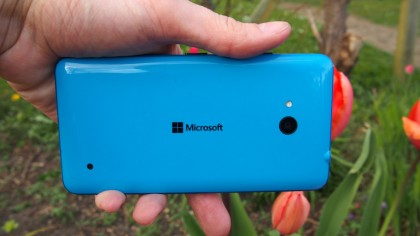
Yet, in most real-life situations, the camera unit in the Lumia 640 is a strong contender for the best snapper in the budget space.
In good lighting, the sensor produced strong levels of detail, along with colours that had a pleasing ‘pop’ without excessive saturation.
Coming with Windows Phone 8.1 Update 2, the Microsoft Lumia 640 is also privy to another exciting feature that first made its debut on higher-end phones in the Lumia line: ‘Rich Capture’.


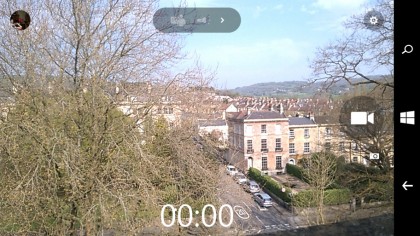
For the uninitiated, this is simply HDR (high dynamic range) but rebranded. When activated, this allows the camera to compensate for high levels of contrast; for example, pulling more detail out of dark shadows on brightly lit days.
With Microsoft’s example of the service, however, this also allows you to select ‘how much’ flash you would like in your low-light shots, improving performance somewhat. The sensor captures two images, one without flash and one with, and combines the two afterwards to achieve the most pleasing result.
Despite this neat trick, low-light photography is not a highlight of the device. Although there is a decent level of brightness in most shots, noise constantly rears its ugly head in almost every scene.
There’s a single 0.9 MP selfie camera on the front of the device, and this – as might be expected – is perfectly acceptable for the odd Skype call, but not for much else. It is certainly not on a par with the likes of the 5MP wide-angle effort on the Lumia 535 and the Lumia 735.
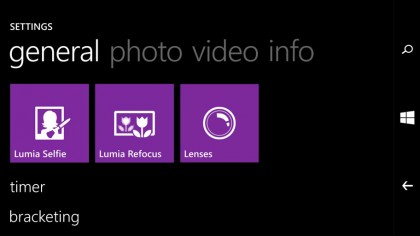
Video is also of decent quality, with the camera handling differences in contrast well and with decent sound levels. Footage can be recorded in 1080p and 720p at 24, 25 and 30 FPS.
At such a low price, and with such competitive specifications in so many other areas, Microsoft might have been content to produce something merely average. However, the Lumia 640 is a good all-round smartphone snapper.
Camera samples

Click here to see the full res image

Click here to see the full res image

Click here to see the full res image

Click here to see the full res image

Click here to see the full res image
Verdict
Using the Microsoft Lumia 640 LTE was an experience that I did not expect to enjoy quite so much. Coming from a Nokia Lumia 930 as my daily driver, I was surprised at how much of the overall quality of the Windows Phone experience could be found at the lower end of the market.
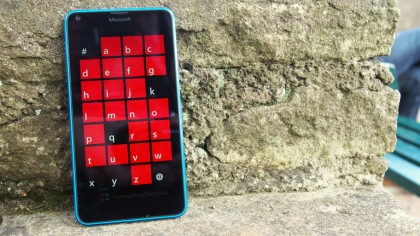
We liked
With a 720p screen that boasts wide-viewing angles and a pixel density of 294 PPI, the Microsoft Lumia 640 is excellent for reading text on the web, gaming and watching movies on the go. Colour accuracy is strong, given that it is an LCD screen, and Glance mode is supported, along with double-tap, which are nice add-ons for the price.
Boasting 2500mAh, the battery life of the Lumia 640 is consistently excellent. It is easy to make it through a full day of work with enough juice to spare for a gaming session on the commute, along with some reading along the way.
The 8MP rear-facing camera is excellent. In most situations, colours are accurately represented and detail is even throughout, with good sharpness levels present consistently. This is supplemented by the clever Rich Capture mode, which makes shooting in low light easier.
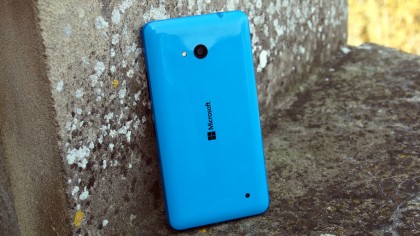
We disliked
Though the Microsoft Lumia 640 is an attractive device, the signature build quality of the Lumia line seems to have been found somewhat lacking, The plastic shell running around the device betrays its budget origins and doesn’t feel as though it could take a knock as easily as its predecessors were able to.
While the Snapdragon 400 is a strong performer, as Qualcomm releases newer chips not only in the 400 line, but others in its budget range, it is a shame to see Windows Phone stuck in the past once again. With the likes of the Moto E (2015) receiving the Snapdragon 410, along with all of its improvements, Windows Phone is once again in danger of looking as though it is stuck in the past.
And, as ever, the app situation on Windows Phone still lags behind. Apps are updated infrequently, if they are present at all, with the store lacking most of the vibrancy that has become a hallmark of the Android and iOS app stores.
Final verdict
Despite its somewhat cheap design and the occasional quirk, the Microsoft Lumia 640 is a remarkably well-rounded device. With an excellent screen, a nice camera, strong battery life and good general performance, this is a phone that should easily suit the lifestyles of most.
This is Microsoft’s challenge to the Moto G, and with sales of the latest device in the line failing to hit the heights set by its predecessor, the time is right to strike.
With 30GB of free OneDrive storage and a year’s subscription to Office 365 for those who purchase the device, the Lumia is an easy sell for most people.
Despite this, two major question marks hang over the device, the first being Windows 10. Set to debut later this year, Microsoft’s major update to its operating ecosystem will bring major changes, and whether these will wash away the tentative footsteps made by Windows Phone into the mobile market is yet to be seen.
The second is simply that of future proofing. As other devices are becoming cheaper and more powerful, especially the likes of the Honor Holly, for how long will besting the Moto G be a true measure of success?
For the price, unlocked and with access to 4G, along with all the other bells and whistles, this is a remarkably complete package from Microsoft, which bodes well for later in the year. This is a smartphone for anyone, and as such is well worth your hard-earned currency.
First reviewed: April 2015
![]()
Related Posts
December 6, 2021
7+ Web Design Trends for 2022: Which Will You Use?
December 6, 2021
The 10 Best WordPress Booking Plugins to Use On Your Website
December 6, 2021
How to Use a Web Cache Viewer to View a Cached Page
November 6, 2021
10 Modern Web Design Trends for 2022
November 6, 2021
Best Free SSL Certificate Providers (+ How to Get Started)
November 6, 2021
How to Design a Landing Page That Sends Conversions Skyrocketing
November 6, 2021
What Are the Best WordPress Security Plugins for your Website?
October 6, 2021
Your Guide to How to Buy a Domain Name
October 6, 2021
How to Build a WordPress Website: 9 Steps to Build Your Site
September 6, 2021
10 Best Websites for Downloading Free PSD Files
September 6, 2021
HTML5 Template: A Basic Code Template to Start Your Next Project
September 6, 2021
How Much Does It Cost to Build a Website for a Small Business?
September 6, 2021
A List of Free Public CDNs for Web Developers
September 6, 2021
6 Advanced JavaScript Concepts You Should Know
August 6, 2021
10 Simple Tips for Launching a Website
August 6, 2021
25 Beautiful Examples of “Coming Soon” Pages
August 6, 2021
10 Useful Responsive Design Testing Tools
August 6, 2021
Best-Converting Shopify Themes: 4 Best Shopify Themes
July 6, 2021
What Is Alt Text and Why Should You Use It?
July 6, 2021
24 Must-Know Graphic Design Terms
June 6, 2021
How to Design a Product Page: 6 Pro Design Tips
April 6, 2021
A Beginner’s Guide to Competitor Website Analysis
April 6, 2021
6 BigCommerce Design Tips For Big Ecommerce Results
April 6, 2021
Is WordPress Good for Ecommerce? [Pros and Cons]
March 6, 2021
Make Websites Mobile-Friendly: 5 Astounding Tips
March 6, 2021
Shopify vs. Magento: Which Platform Should I Use?
March 6, 2021
Top 5 Web Design Tools & Software Applications
February 6, 2021
Website Optimization Checklist: Your Go-To Guide to SEO
February 6, 2021
5 UX Design Trends to Dazzle Users in 2021
February 6, 2021
What Is the Average Page Load Time and How Can You Do Better?
February 6, 2021
Choosing an Ecommerce Platform That Will Wow Customers
February 6, 2021
7 Best Practices for Crafting Landing Pages with Forms
February 6, 2021
7 B2B Web Design Tips to Craft an Eye-Catching Website
January 6, 2021
Mobile-Friendly Checker | Check Your Site’s Mobile Score Now
January 6, 2021
8 Tips for Developing a Fantastic Mobile-Friendly Website
December 6, 2020
How to Add an Online Store to Your Website [4 Ways]
December 6, 2020
5 UX Design Tips for Seamless Online Shopping
November 6, 2020
Ecommerce Website Essentials: Does Your Site Have All 11?
November 6, 2020
5 Small Business Website Essentials You Need for Your Site
November 6, 2020
Your Website Redesign Checklist for 2020: 7 Steps for Success
May 1, 2020
Psychology of Color [Infographic]
April 21, 2020
How to start an online store that drives huge sales
January 3, 2020
5 Lead Generation Website Design Best Practices
March 6, 2019
6 Reasons You Should Redesign Your Website in 2019
March 6, 2019
7 Web Design Trends for 2019
February 19, 2019
Who owns the website/app source code, client or developer
February 7, 2019
Don’t Let Your Domain Names Expire in 2019
January 8, 2019
2019 Website Development Trends To Note
October 6, 2017
How Web Design Impacts Content Marketing
October 6, 2017
How to Choose a Navigation Setup
August 6, 2017
Why User Experience Matters to Marketing
July 6, 2017
5 Ways Web Design Impacts Customer Experience
September 6, 2016
How to Learn Angular
September 6, 2016
The Excuses for Not Having a Website (Infographic)
September 6, 2016
How to Build an Award-Winning Web Design Team
September 6, 2016
13 Free Data Visualization Tools
August 6, 2016
How Selling Pastries Helped Us Design a Better Product
August 6, 2016
11 Sites to Help You Find Material Design Inspiration
July 4, 2016
How to change free wordpress.com url
April 6, 2016
The 5 Best Free FTP Clients
April 6, 2016
7 Free UX E-Books Worth Reading
March 6, 2016
Can Handwritten Letters Get You More Clients?
December 10, 2015
Star Wars Week: How to create your own Star Wars effects for free
December 6, 2015
20 "Coming Soon" Pages for Inspiration
December 6, 2015
6 Free Tools for Creating Your Own Icon Font
December 6, 2015
9 Useful Tools for Creating Material Design Color Palettes
November 6, 2015
20 Free UI Kits to Download
November 6, 2015
50 Web Designs with Awesome Typography
November 6, 2015
When to Use rel="nofollow"
November 6, 2015
7 Free Books That Will Help You Become More Productive
November 6, 2015
50 Beautiful One-Page Websites for Inspiration
November 6, 2015
Circular Images with CSS
October 6, 2015
Lessons Learned from an Unsuccessful Kickstarter
October 6, 2015
5 Games That Teach You How to Code
October 6, 2015
Cheatsheet: Photoshop Keyboard Shortcuts
October 6, 2015
An Easy Way to Create a Freelance Contract for Your Projects
October 6, 2015
50 Design Agency Websites for Inspiration
September 29, 2015
JB Hi-Fi shutting the book on ebooks
September 24, 2015
Opinion: Quick, Quickflix: It's time to give yourself the flick
September 24, 2015
New Star Wars 360-degree video is among first on Facebook
September 21, 2015
Apple purges malicious iPhone and iPad apps from App Store
September 12, 2015
Apple's new Live Photos feature will eat up your storage
September 12, 2015
The latest Windows 10 Mobile preview has been delayed
September 12, 2015
IBM buys StrongLoop to add Node.js development to its cloud
September 8, 2015
Fake Android porn app takes your photo, then holds it ransom
September 6, 2015
50 Restaurant Websites for Inspiration
September 6, 2015
Zero UI — The Future of Interfaces
September 6, 2015
50 Beautiful Websites with Big Background Images
September 6, 2015
Infographic: 69 Web Design Tips
September 6, 2015
Free Windows 10 Icons
September 2, 2015
Instagram turns itself into a genuine messaging service
August 11, 2015
In Depth: How Microsoft taught Cortana to be more human
August 11, 2015
Windows 10 price, news and features
August 11, 2015
Windows 10's broken update introduces endless reboot loop
August 11, 2015
Windows 10 races to 27m installs
August 11, 2015
Windows 10 IoT Core gets first public release
August 10, 2015
iOS Tips: How to backup iPhone to an external drive
August 10, 2015
Windows 8.1 RT finally getting Windows 10 Start Menu
August 10, 2015
How to use Windows Hello
August 10, 2015
Review: Moto Surround
August 10, 2015
Review: Moto G (2015)
August 9, 2015
8 of the best free VPN services
August 8, 2015
Use Firefox? Mozilla urges you update ASAP
August 7, 2015
Mac Tips: Apple Mail: How to remove the Favorites Bar
August 7, 2015
How to make the OS X dock appear faster
August 7, 2015
Review: BQ Aquaris E45 Ubuntu Edition
August 7, 2015
Review: Acer Liquid Jade Z
August 6, 2015
How to reinstall Linux
August 6, 2015
How to reinstall Windows
August 6, 2015
Updated: Apple Music: release date, price and features
August 6, 2015
Social News Websites for Front-End Developers
August 6, 2015
10 Free JavaScript Books
August 6, 2015
50 Beautiful Blog Designs
August 6, 2015
Animated SVG Pipes Effect
August 6, 2015
Launching Your First App
August 5, 2015
Windows 10 goes freemium with paid apps
August 5, 2015
Updated: Week 1 with Windows 10
August 5, 2015
Mac Tips: How to manage Safari notifications on Mac
August 5, 2015
Microsoft Sway may kill the PowerPoint presentation
August 4, 2015
Microsoft gives Outlook on the web a new look
August 4, 2015
Mac OS X vulnerable to new zero-day attack
August 4, 2015
Windows 10 users warned of two scams
August 4, 2015
Microsoft's Docs.com is now available to everyone
August 3, 2015
Mac Tips: How to edit the Favorites sidebar on Mac
August 3, 2015
Updated: Windows 10 price, news and features
July 29, 2015
Review: HP ProDesk 405 G2
July 29, 2015
Hands-on review: HP Elite x2 1011
July 29, 2015
Hands-on review: Updated: Windows 10 Mobile
July 29, 2015
Review: Updated: Nvidia Shield Android TV
July 28, 2015
LIVE: Windows 10 launch: Live Blog!
July 28, 2015
How to prepare for your upgrade to Windows 10
July 28, 2015
Review: Updated: Windows 10
July 28, 2015
Review: Updated: HP Pro Tablet 608
July 28, 2015
Review: Heat Genius
July 28, 2015
Hands-on review: Moto X Play
July 28, 2015
Hands-on review: Moto X Style
July 28, 2015
Hands-on review: Moto G (2015)
July 28, 2015
Review: 13-inch MacBook Air (early 2015)
July 28, 2015
Hands-on review: OnePlus 2
July 28, 2015
Review: LG 65EG960T 4K OLED
July 28, 2015
Mac Tips: How to share printers on Mac
July 27, 2015
Apple Music's arrival hasn't opened Pandora's box
July 26, 2015
Review: Garmin Swim
July 25, 2015
How to merge OS X contacts into an existing list
July 25, 2015
Hands-on review: UPDATED: ZTE Axon
July 24, 2015
Mac Tips: How to zoom in on a Mac
July 24, 2015
What Windows 10 means for the enterprise
July 24, 2015
Review: JBL Charge 2 Plus
July 24, 2015
Review: Acer Aspire S7
July 24, 2015
Review: Updated: Canon G3 X
July 24, 2015
Review: Updated: iPad Air 2
July 24, 2015
Review: Thinksound On1
July 24, 2015
Review: Asus Chromebook Flip
July 24, 2015
Review: Garmin Forerunner 225
July 23, 2015
Review: Garmin nuvi 68LM
July 23, 2015
Review: Samsung Galaxy S6 Active
July 23, 2015
Review: Bowers and Wilkins P5 Wireless
July 23, 2015
Review: Dell XPS 15 (2015)
July 21, 2015
Review: Fuji S9900W
July 21, 2015
Review: Updated: Fitbit Surge
July 21, 2015
Review: UE Roll
July 21, 2015
Hands-on review: Ubik Uno
July 20, 2015
Review: Samsung HW-J650
July 20, 2015
Updated: 40 best Android Wear smartwatch apps 2015
July 20, 2015
Review: Acer Chromebook C740 review
July 20, 2015
Review: Huawei Talkband B2
July 20, 2015
Review: Dell Venue 10 7000
July 20, 2015
Review: Intel Core i7-5775C
July 17, 2015
Mac Tips: How to delete locked files on Mac
July 17, 2015
Review: Pebble Time
July 16, 2015
Microsoft just made Windows XP even less secure
July 16, 2015
Windows 8.1 RT is getting an update this September
July 16, 2015
OS showdown: Windows 10 vs Windows 8.1 vs Windows 7
July 16, 2015
Review: Acer CB280HK
July 15, 2015
Windows 10 is ready for new laptops and PCs
July 15, 2015
Explained: How to take a screenshot in Windows
July 15, 2015
Office for Windows 10 appears in latest build
July 14, 2015
Review: ZTE Axon
July 14, 2015
Review: ViewSonic VP2780-4K
July 14, 2015
Hands-on review: SanDisk Connect Wireless Stick
July 14, 2015
Review: Oppo PM-3
July 14, 2015
Review: BT 11ac Dual-Band Wi-Fi Extender 1200
July 14, 2015
Review: Fuji X-T10
July 13, 2015
How to build an SEO strategy for your business
July 13, 2015
Review: Lenovo ThinkPad Yoga 15
July 13, 2015
Review: Audio-Technica ATH-MSR7
July 13, 2015
Review: Garmin NuviCam LMT-D
July 13, 2015
Review: Dell Inspiron 13 7000
July 13, 2015
Hands-on review: AstroPi SenseHAT
July 13, 2015
Hands-on review: EE Rook
July 13, 2015
Hands-on review: Updated: HTC Vive
July 12, 2015
Here's the ultimate software list for PC fanatics
July 10, 2015
How to use the new Photos app for Mac
July 10, 2015
Windows 10 Insider Preview Build 10166 available now
July 10, 2015
Splunk spends big on cybersecurity acquisition
July 10, 2015
Making Windows 10 apps just got a whole lot easier
July 10, 2015
Review: Lenovo LaVie Z 360
July 9, 2015
OS X El Capitan public beta available right now
July 9, 2015
Microsoft finally unveils Office 2016 for Mac
July 9, 2015
Review: Updated: Chromecast
July 9, 2015
Review: Updated: Tesco Hudl 2
July 9, 2015
Review: Lenovo ThinkPad E550
July 9, 2015
Review: Updated: Google Nexus 6
July 8, 2015
What you need to know about Windows Server 2016
July 7, 2015
Microsoft to hike enterprise cloud pricing
July 6, 2015
Hacking Team end up being totally 0wned
July 6, 2015
Review: HP Pro Slate 12
July 6, 2015
Review: Samsung 850 Pro 2TB
July 6, 2015
Review: Asus RT-AC87U
July 6, 2015
Review: Jawbone UP2
July 6, 2015
Reimagining the Web Design Process
July 6, 2015
50 Clean Websites for Inspiration
July 6, 2015
15 Free Books for People Who Code
July 6, 2015
Web Storage: A Primer
July 6, 2015
A Look at Some CSS Methodologies
July 3, 2015
6 Essential Mac Mouse and Trackpad Tips
July 2, 2015
How to install a third party keyboard on Android
July 2, 2015
Review: UPDATED: Asus Zenfone 2
July 2, 2015
Review: Alienware 13
July 2, 2015
Review: HP DeskJet 1010
July 1, 2015
5 issues we want Apple Music to fix
June 13, 2015
Cortana will get its own button on Windows 10 PCs
June 12, 2015
Windows 10 will come with universal Skype app
June 12, 2015
iPad music production: 18 Best apps and gear
June 12, 2015
Windows 10 all set for early enterprise struggle
June 12, 2015
Review: Garmin VIRB Elite
June 11, 2015
Review: Updated: Nvidia Shield Tablet
June 11, 2015
Review: Nokia Lumia 635
June 10, 2015
Microsoft brings more online tweaks to Office 365
June 10, 2015
Mac Tips: How to use Screen Sharing in Mac OS X
June 9, 2015
Hands-on review: Meizu M2 Note
June 9, 2015
Hands-on review: EE 4GEE Action Camera
June 9, 2015
Review: Toshiba 3TB Canvio external hard drive
June 9, 2015
Review: Olympus SH-2
June 8, 2015
Hands-on review: Updated: Apple CarPlay
June 8, 2015
UPDATED: iOS 9 release date, features and news
June 8, 2015
Review: Updated: Roku 2
June 8, 2015
Review: Updated: PlayStation Vue
June 8, 2015
Review: Dell PowerEdge R730
June 8, 2015
Review: Canon SX710 HS
June 7, 2015
UPDATED: iOS 9 release date, features and rumors
June 7, 2015
Review: Lenovo S20-30
June 6, 2015
Free Writing Icons
June 6, 2015
15 CSS Questions to Test Your Knowledge
June 6, 2015
The Best CSS Reset Stylesheets
June 6, 2015
How CSS Specificity Works
June 5, 2015
'Delay' is a new feature in Windows 10
June 5, 2015
Review: Beyerdynamic Custom One Pro Plus
June 5, 2015
Latest SEO Marketing tools
June 5, 2015
Review: Nvidia Shield Android TV
June 5, 2015
Review: Honor 4X
June 5, 2015
Review: In Depth: Oppo R5
June 3, 2015
Hands-on review: Huawei P8 Lite
June 3, 2015
How To: How to create eBooks on a Mac
June 3, 2015
Review: Updated: Tidal
June 3, 2015
Review: Canon 750D (Rebel T6i)
June 2, 2015
Review: Updated: Asus ZenWatch
June 2, 2015
Review: Alcatel OneTouch Idol 3
June 2, 2015
Review: Updated: Nokia Lumia 1520
June 2, 2015
Review: Updated: Yotaphone 2
June 2, 2015
Review: Updated: Nokia Lumia 625
June 2, 2015
Review: Creative Muvo Mini
June 1, 2015
Review: Acer TravelMate P645 (2015)
June 1, 2015
Hands-on review: Corsair Bulldog
May 29, 2015
In Depth: NetApp: a requiem
May 29, 2015
July is looking definite for Windows 10 release
May 29, 2015
Hands-on review: Google Photos
May 28, 2015
Mac Tips: The 16 best free GarageBand plugins
May 28, 2015
Review: Canon 760D (Rebel T6s)
May 27, 2015
Review: Lenovo Yoga 3 14
May 27, 2015
Hands-on review: Serif Affinity Photo
May 27, 2015
Review: Garmin Vivoactive
May 26, 2015
Review: Datacolor Spyder5 Elite
May 26, 2015
Hands-on review: Sony Xperia Z3+
May 26, 2015
Review: Epson BrightLink Pro 1410Wi
May 26, 2015
Review: Technics Premium C700
May 26, 2015
Review: Canon EOS M3
May 26, 2015
Review: Updated: HTC One M9
May 26, 2015
Review: Updated: Sony Xperia Z3 Compact
May 25, 2015
Review: Updated: New Nintendo 3DS
May 25, 2015
Updated: 50 best Mac tips, tricks and timesavers
May 25, 2015
Updated: Windows email: 5 best free clients
May 25, 2015
Instagram is planning to invade your inbox
May 25, 2015
Review: Updated: Foxtel Play
May 24, 2015
How Windows 10 will change smartphones forever
May 24, 2015
Review: Vodafone Smart Prime 6
May 24, 2015
Review: Updated: iPad mini
May 22, 2015
Office Now may be Cortana for your work life
May 22, 2015
Review: Updated: Lenovo Yoga 3 Pro
May 22, 2015
Review: Updated: Fitbit Flex
May 21, 2015
Updated: Best free Android apps 2015
May 21, 2015
Review: Asus ZenBook Pro UX501
May 21, 2015
Review: Sennheiser Momentum In-Ear
May 20, 2015
Hands-on review: UPDATED: Asus Zenfone 2
May 20, 2015
OS X 10.11 release date, features and rumors
May 18, 2015
Updated: Best free antivirus software 2015
May 18, 2015
iPhone 6S rumored to launch as soon as August
May 18, 2015
Microsoft ready to pounce and acquire IFS?
May 17, 2015
5 of the most popular Linux gaming distros
May 16, 2015
Review: Acer Chromebook 15 C910
May 16, 2015
Review: Lenovo ThinkPad X1 Carbon (2015)
May 16, 2015
Review: Polk Nue Voe
May 16, 2015
The top 10 data breaches of the past 12 months
May 16, 2015
Hands-on review: Updated: LG G4
May 16, 2015
Review: Updated: Quickflix
May 16, 2015
Review: LG Watch Urbane
May 16, 2015
Review: Razer Nabu X
May 16, 2015
Hands-on review: Updated: Windows 10
May 16, 2015
Review: UPDATED: Moto X
May 16, 2015
Review: Updated: Moto G (2013)
May 12, 2015
Review: TomTom Go 50
May 12, 2015
Review: Updated: Moto G (2014)
May 12, 2015
Review: Garmin Vivofit 2
May 12, 2015
Review: Asus Transformer Book Flip TP300LA
May 11, 2015
Review: MSI GT80 Titan
May 11, 2015
Review: Monster SuperStar BackFloat
May 9, 2015
Review: Updated: Apple Watch
May 7, 2015
5 million internet users infected by adware
May 7, 2015
Review: Updated: New MacBook 2015
May 6, 2015
Android M will be shown at Google IO 2015
May 6, 2015
Review: Epson WorkForce Pro WF-4630
May 6, 2015
Review: Master & Dynamic MH40
May 6, 2015
How to Use Gulp
May 6, 2015
Getting Started with Command-Line Interfaces
May 6, 2015
What It’s Like to Contribute to WordPress
May 6, 2015
Ultimate Guide to Link Types for Hyperlinks
May 6, 2015
11 Things You Might Not Know About jQuery
May 5, 2015
Hands-on review: Updated: PlayStation Now
May 5, 2015
Review: Lenovo ThinkPad Yoga 12
May 5, 2015
Review: Updated: iPad Air
May 5, 2015
Review: Panasonic SZ10
May 5, 2015
Review: Updated: Fetch TV
May 4, 2015
Review: Cambridge Audio Go V2
May 3, 2015
Review: Lightroom CC/Lightroom 6
May 2, 2015
5 of the most popular Raspberry Pi distros
May 1, 2015
Review: PlayStation Vue
May 1, 2015
Hands-on review: Updated: Microsoft HoloLens
April 30, 2015
Build 2015: Why Windows 10 may not arrive until fall
April 29, 2015
The biggest announcements from Microsoft Build 2015
April 29, 2015
Hands-on review: TomTom Bandit
April 29, 2015
Hands-on review: EE Harrier Mini
April 28, 2015
Review: Samsung NX500
April 28, 2015
Hands-on review: LG G4
April 28, 2015
Review: Patriot Ignite 480GB SSD
April 28, 2015
Hands-on review: EE Harrier
April 28, 2015
Review: Linx 10
April 28, 2015
Review: 1&1 Cloud Server
April 26, 2015
Hands-on review: Acer Iconia One 8
April 25, 2015
How to run Windows on a Mac with Boot Camp
April 24, 2015
Dropbox Notes poised to challenge Google Docs at launch
April 24, 2015
Hands-on review: Acer Aspire E14
April 24, 2015
Hands-on review: UPDATED: Valve Steam Controller
April 24, 2015
Review: Acer Iconia One 7
April 23, 2015
Windows 10 just revived everyone's favorite PC game
April 23, 2015
Google opens up Chromebooks to competitors
April 23, 2015
Here's how Outlook 2016 looks on Windows 10
April 23, 2015
Hands-on review: Updated: Acer Liquid M220
April 23, 2015
Hands-on review: Acer Aspire Switch 10 (2015)
April 23, 2015
Hands-on review: Acer Aspire R 11
April 22, 2015
Review: Alienware 17 (2015)
April 22, 2015
Hands-on review: Updated: HP Pavilion 15 (2015)
April 21, 2015
This is how Windows 10 will arrive on your PC
April 21, 2015
Review: iMac with Retina 5K display
April 21, 2015
Review: Epson XP-420 All-in-One
April 18, 2015
Google Now brings better search to Chrome OS
April 17, 2015
Review: Epson Moverio BT-200
April 17, 2015
Review: Pentax K-S2
April 16, 2015
Updated: Android Lollipop 5.0 update: when can I get it?
April 15, 2015
Hands-on review: Updated: Huawei P8
April 15, 2015
Review: SanDisk Ultra Dual USB Drive 3.0
April 15, 2015
Review: Updated: LG G3
April 15, 2015
Review: Updated: LG G3
April 15, 2015
Review: Crucial BX100 1TB
April 13, 2015
iOS 8.4 beta reveals complete Music app overhaul
April 13, 2015
Linux 4.0: little fanfare for a tiny new release
April 13, 2015
Achievement unlocked: Microsoft gamifies Windows 10
April 13, 2015
Best Android Wear smartwatch apps 2015
April 13, 2015
Review: Acer Aspire R13
April 12, 2015
Review: TP-Link Archer D9
April 10, 2015
Microsoft's new browser arrives for Windows 10 phones
April 10, 2015
Review: LG UltraWide 34UC97
April 9, 2015
Office now integrates with Dropbox on the web
April 9, 2015
Now you can buy video games with Apple Pay
April 9, 2015
Updated: iOS 8 features and updates
April 9, 2015
Microsoft's stripped down Nano Server is on the way
April 8, 2015
Skype Translator gets even more features
April 8, 2015
Windows mail services hit by widespread outages
April 8, 2015
Review: UPDATED: Amazon Echo
April 8, 2015
Hands-on review: Dell Venue 10 7000
April 8, 2015
Review: Updated: OS X 10.10 Yosemite
April 7, 2015
Google's GMeet could kill teleconferencing
April 7, 2015
Is Redstone the first Windows 10 update?
April 7, 2015
Next peek at Windows Server 2016 due next month
April 7, 2015
Review: Acer Aspire Switch 11
April 7, 2015
Review: Adobe Document Cloud
April 6, 2015
Hands-on review: Updated: New MacBook 2015
April 6, 2015
Freebie: 100 Awesome App Icons
April 6, 2015
Six Revisions Quarterly Report #1
April 6, 2015
A Modern Approach to Improving Website Speed
April 6, 2015
Disable Text Selection with CSS
April 4, 2015
Review: Nikon D7200
April 3, 2015
Amazon Prime video now streams to any Android tablet
April 3, 2015
Review: Google Cardboard
April 3, 2015
Review: MSI WS60
April 2, 2015
Chrome users can now run 1.3 million Android apps
April 2, 2015
See Windows 10 Mobile running on an Android handset
April 2, 2015
Review: Mini review: Macphun Noiseless Pro 1.0
April 2, 2015
Review: Intel SSD 750 Series 1.2TB
April 2, 2015
Review: BenQ TreVolo
April 2, 2015
Hands-on review: Nikon 1 J5
April 1, 2015
Microsoft launches Windows 10 music and video apps
April 1, 2015
Review: mini review: Sony XBA-H1
December 19, 2014
Review: CoPilot Premium sat nav app
December 19, 2014





























































































































































































































































































































































































































































































































































































